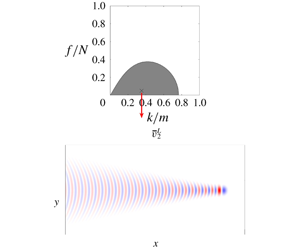Article contents
Mean flows induced by inertia–gravity waves in a vertically confined domain
Published online by Cambridge University Press: 11 March 2020
Abstract

The Lagrangian-mean motion of fluid particles induced by horizontally localized small-amplitude wavepackets of vertically trapped inertia–gravity waves is computed analytically, at second order in wave amplitude, and the results are supported by direct nonlinear numerical simulations. The leading-order motion is assumed to be inertia–gravity waves, which is applicable to oceanic mesoscale flows in regions where wave activity is as strong as or stronger than the balanced flow. The analytical computation is based on time-dependent asymptotic wave–mean interaction theory, and the numerical simulation uses a Galerkin-truncated  $f$-plane nonlinear hydrostatic Boussinesq model that retains the barotropic mode and two baroclinic modes (vertical wavenumbers 0,
$f$-plane nonlinear hydrostatic Boussinesq model that retains the barotropic mode and two baroclinic modes (vertical wavenumbers 0,  $m$ and
$m$ and  $2m$), this being the minimal set on which consistent wave–mean interactions can take place. Two novel dynamical effects are revealed: First, we find that the barotropic component robustly dominates the Lagrangian-mean flow response, which is contrary to earlier findings for the same problem. Second, we discovered a new wavepacket regime in which the baroclinic mean-flow response consists of the persistent radiation of resonantly forced secondary internal waves. The latter effect occurs in an oceanically accessible parameter regime.
$2m$), this being the minimal set on which consistent wave–mean interactions can take place. Two novel dynamical effects are revealed: First, we find that the barotropic component robustly dominates the Lagrangian-mean flow response, which is contrary to earlier findings for the same problem. Second, we discovered a new wavepacket regime in which the baroclinic mean-flow response consists of the persistent radiation of resonantly forced secondary internal waves. The latter effect occurs in an oceanically accessible parameter regime.
- Type
- JFM Papers
- Information
- Copyright
- © The Author(s), 2020. Published by Cambridge University Press
References
- 2
- Cited by


